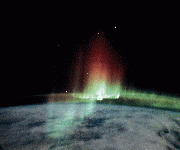The Solar Wind and Aurorae
 From the beautiful aurorae to magnetic storms, the solar wind plays a large part in what goes on in the Earth's magnetosphere. Here we will look a little more closely at how the solar wind affects the Earth.
From the beautiful aurorae to magnetic storms, the solar wind plays a large part in what goes on in the Earth's magnetosphere. Here we will look a little more closely at how the solar wind affects the Earth.
Magnetospheric substorms happen when increased energy flows from the solar wind into the magnetosphere near the poles of the Earth. They last about a half hour. They could be a result of a coronal mass ejection or some other type of solar activity. For a satellite view, go here.

Aurora
One better-known effect of the magnetospheric substorm is called the aurora, also known as the northern lights. The aurora takes place when the solar wind collides with the Earth's ionosphere. Atmospheric particles become excited during the collision. They need to release energy in order to return to their normal ground state. This energy is seen by us as bursts of colored lights in the sky. When a substorm develops into a full magnetic storm, the aurora are closer to the Earth's surface and more intense.